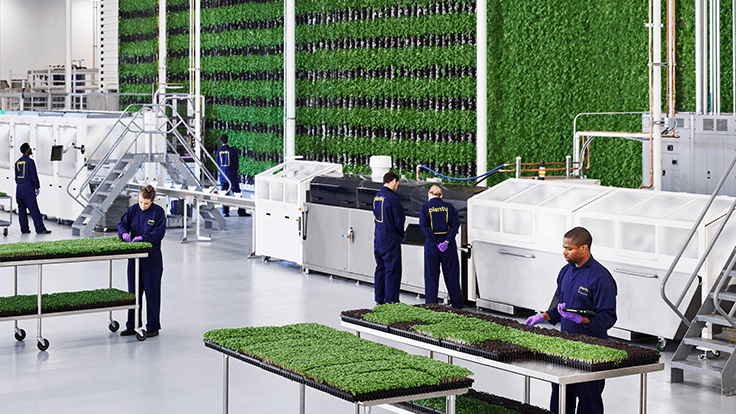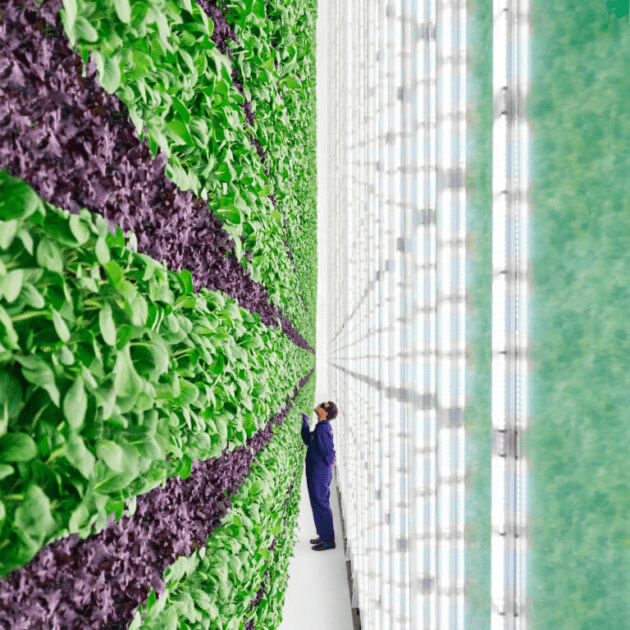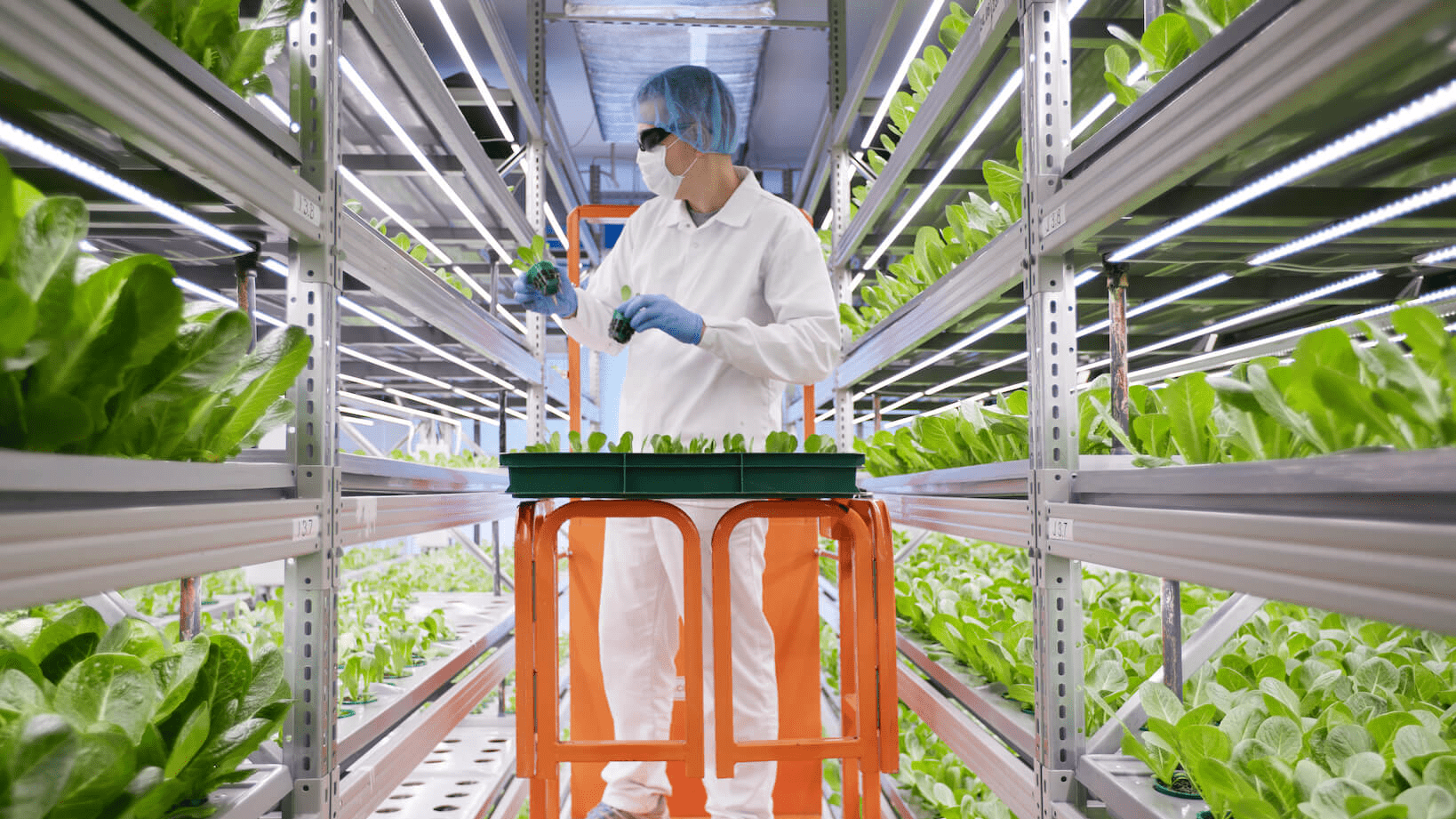Dec 5, 2022
The Influx of CEA Investment: Where Has the Money Gone?
.png)
High-tech farming operations like Plenty’s require significant funding, often sourced from investors and venture capitalists. Credit: Produce Grower.
WRITTEN BY: Ricky Stephens
December 5, 2022
Just five years ago, in 2017, a little-known company named Plenty raised what was, at the time, the largest agtech investment deal to date: a $200M Series B. Up to that time, indoor farming companies had generally been cobbling together money from whomever they could. Prior to this, the largest VC funding round in the sector was AeroFarms’ Series D, just one-fifth the size of Plenty’s raise at $40M.

A worker inspects plants in one of Plenty’s vertical farms. Credit: Geekwire.
The Plenty deal has marked a turning point. In the years that have followed, venture capital money has poured into the controlled environment agriculture (CEA) space at a dizzying pace. In 2017, Plenty’s round accounted for more than 30% of the $652M in private investment toward novel farming systems, as tracked by AgFunderNews in their annual AgriFood Tech Investment Report. By 2021, this annual investment figure had grown by more than 250% to reach $2.3B – a 37% CAGR! – per AgFunder’s most recent report.
But at the end of this year, in the midst of this global economic downturn, a correction has come, and we’ve now witnessed multiple CEA farm shutdowns, and several others lay off significant staff numbers in recent weeks. Almost all are talking about the difficult fundraising environment that likely lies ahead.
Heading into 2023, a new pathway for the CEA sector seems to be taking root: one focused less on hype and growth at all costs and more on profitability. Given this likely inflection point we find ourselves in today, Agritecture wanted to look at the state of CEA startup investing to date. How much total money has flowed in? Where has this money gone? And what does this tell us?
At least $7.1B raised to date

Vertical farms require significant capital to operate, especially when they’re just starting out. Credit: Global AgInvesting.
To better understand the flow of investments, we combined internal data and data from Crunchbase to identify nearly 50 companies that have raised at least $10 million in private investment to date and either operate or sell technology within the CEA produce sector (primarily greens, herbs, berries, tomatoes, and mushrooms).
It’s noteworthy that this leaves out several other types of companies, including cannabis-only growers and technology providers, indoor aquaculture startups, and controlled environment insect rearing. It also excludes publicly traded companies, some startups that have not disclosed funding amounts, and of course, a number of earlier-stage startups that have raised less than $10M.
We categorized these companies into three primary groups:
-
Farm operators: Companies that operate actual farms and earn revenue through the sale of produce through their own brands.
-
Technology providers: Companies that develop equipment and technology that they sell to farm operators.
-
Farm/tech hybrids: Companies that operate farms and develop the technology to run them; sometimes referred to as farming-as-a-service. These companies tend to partner with existing consumer brands.
Regarding the number of companies, 60% are farm operators, 20% are tech providers, and 20% are farm/tech hybrids. Yet in terms of amount of funding received, farm operators have dominated, receiving 86% of the $7.1B total.
Vertical farms and leafy greens continue to lead the way, but not by much

90% of startup funding in the indoor ag sector has gone toward CEA operators that grow leafy greens. Credit: Why Farm It.
Conversations on the controlled environment agriculture space usually lead to comparisons between vertical farms (VFs) and greenhouses (GHs). Their distinctions are important to understand because they differ in terms of capital costs, energy use, payback periods, and plants that can be grown profitably. Our analysis reveals that vertical farm operators are indeed outdueling greenhouse operators, but not by much – $3.3 billion (55%) to $2.3 billion (37%), respectively, with hybrid VF-GH companies making up the remaining $488 million (8%). When it comes to tech providers and farm-tech hybrids, funding is actually evenly split between those focused on vertical farming tech ($497M) and those focused on greenhouse tech ($490M).
Looking at the types of crops being grown by farms, leafy greens dominate. Currently, 90% of total funding has gone toward CEA operators that grow leafy greens. Herbs were the second-most represented crop, with 48% of total funding going to operators producing herbs. Surprisingly, berries hopped into the third-most represented, with 25% of total funding having been received by operators growing berries. Tomatoes (19% of total funding) and microgreens (11%) round out other noteworthy crops.
A handful of companies command the funding landscape

Bowery Farming, featured here, plus Plenty and AppHarvest, have collectively raised about ⅓ of the total startup funding for CEA to date. Credit: Greenhouse Grower.
While the CEA sector is continuing to see new startups emerge, the investment landscape is dominated by just a handful of companies.
Plenty, Bowery Farming, and AppHarvest lead the way, having raised nearly 1/3 of the $7.1B fundraising amount. Further examination shows that the top 11 companies, including InFarm, Soli Organic, Gotham Greens, Little Leaf Farms, Local Bounti, Pure Harvest, 80 Acres, and AeroFarms, represent 3/4 of the total. It’s noteworthy that these 11 are evenly split between vertical farming operators and greenhouse growers.
Finally, looking into geographical trends, US-based startups have dominated: 26 of the 43 companies (60%) are based in the States, and they've collectively raised 79% of the total funding figure. European companies represent another 9 of the companies and have collected 13% of the fundraising total. One exception here is the controlled environment insect space (again, not considered in the rest of this analysis), where three of the four startups that have collectively raised $1 billion are located in France.
What does this tell us?

A vertical hydroponic farm in the UK. Credit: Time Out.
As industry advisors who take a measured and data-driven approach, Agritecture has had mixed feelings about the explosion in VC investment over the past several years. While excited by the sector’s growth, the advancements in new technologies particularly around automation, and the signal of confidence from investors, we felt frustrated by the exaggerated claims, greenwashing, and lack of transparency that we saw – all things that unfortunately tend to coincide with an investment frenzy.
We also questioned how realistic growth projections were and why so many farm operators continued to try to build their own technology from scratch. Based on several of these factors, our Founder & CEO predicted a correction was imminent in an AgFunderNews opinion piece at the end of 2021.
When we ran the numbers, we were surprised to see just how much of this $7.1B has gone to farm operators rather than enabling technology and equipment providers. On top of this, the fact that 90% of the funding to farm operators has gone to those growing leafy greens, tells us that there was likely a lot of redundancy with many of these business models. As the pressure shifts from hyper-growth to healthy unit economics, we will get a good glimpse at what specific business model iterations have given certain operators advantages over others. Of course, we have our opinions based on both predicted and observed models.

Investment funding in CEA often goes to farm operators to allow them to continue their work. Credit: iFarm.
It’s also important to keep in mind that venture capital, while a great indicator of emerging innovation in a sector, is not the be-all and end-all signal of the future success of an industry. The vast majority of VC-backed startups fail and return no money to investors (75% by one estimate). Outside of the US in particular, many large greenhouse operators have been in existence for decades and have enough operating history to finance their expansion plans through bank debt, or even their own profits. But many of these more traditional growers have been slower to embrace new innovations. Will that begin to change? And will we begin to see a more clear division between technology provider and farm operator? Or will the dividing line instead be more between farm operator and consumer brand?
Let’s remember to take a step back and see the big picture. All technologies go through cycles of capital influx, inflated expectations, and correction periods. What matters most is whether we can learn from each cycle to get to the objective: growing more with fewer resources. This may seem like a treacherous time for the CEA industry, and many questions remain, but Agritecture is excited about a future that should be based less on over-engineered technology and false promises, and more on proper planning and realistic growth scenarios.
